Abstract
In this study, we have extended and completed a previous investigation (P. Messner, R. Christian, J. Kolbe, G. Schulz, and U. B. Sleytr, J. Bacteriol. 174:2236-2240, 1992) in which we demonstrated for the first time in prokaryotic organisms the presence of a novel O-glycosidic linkage via tyrosine. The surface layer glycoprotein of the eubacterium Clostridium thermohydrosulfuricum S102-70 is arranged in a hexagonal lattice, with center-to-center spacings of approximately 16.3 nm. Molecular weight determination by sodium dodecyl sulfate-polyacrylamide gel electrophoresis of both glycosylated and chemically deglycosylated surface layer glycoprotein showed values for the monomeric subunits of 94,000 and 87,500, respectively. Glycopeptide fractions obtained after exhaustive pronase digestion of purified, intact glycoprotein were isolated by reversed-phase liquid chromatography. One- and two-dimensional nuclear magnetic resonance studies, together with chemical analyses and plasma desorption time-of-flight mass spectrometry, were used to elucidate the structure of the hexasaccharide moiety linked by the novel O-glycosidic linkage to tyrosine. The combined evidence suggests the following structure: beta-D-Galf-(1-->3)-alpha-D-Galp- (1-->2)-alpha-L-Rhap-(1-->3)-alpha-D-Manp-(1--3)-alpha-L- Rhap-(1-->3)-beta- D-Glcp-(1-->4)-L-Tyr.
Full text
PDF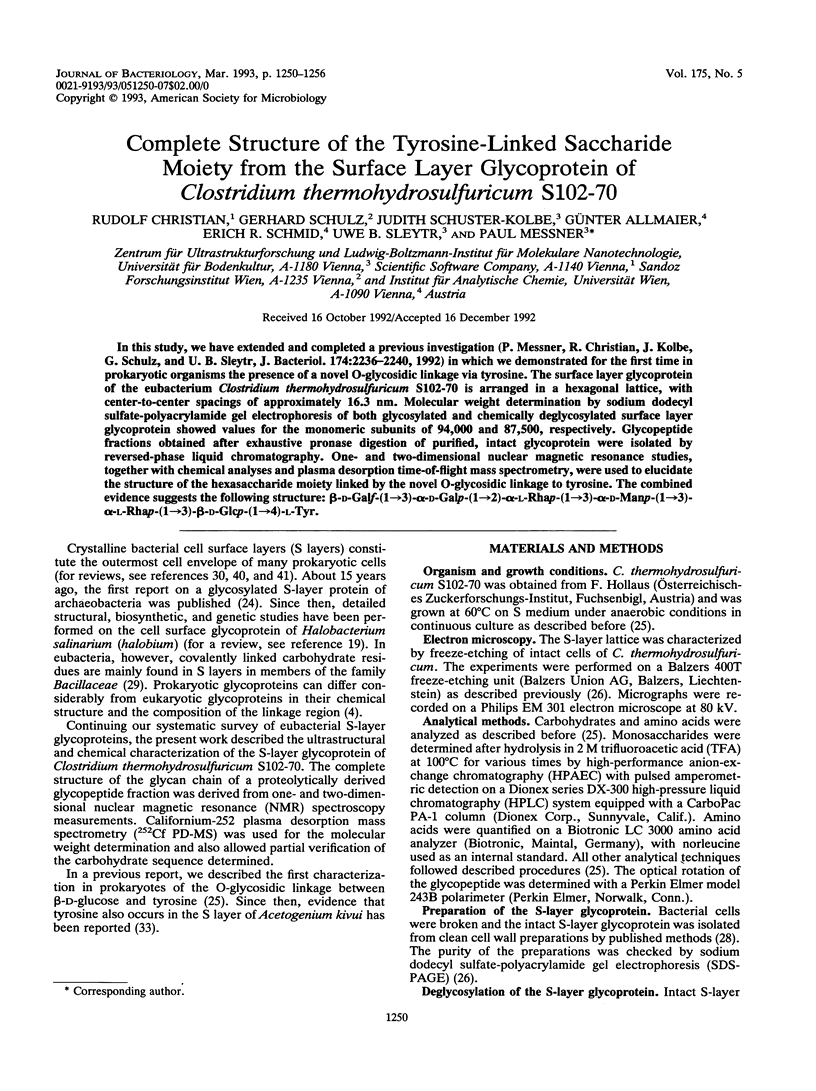
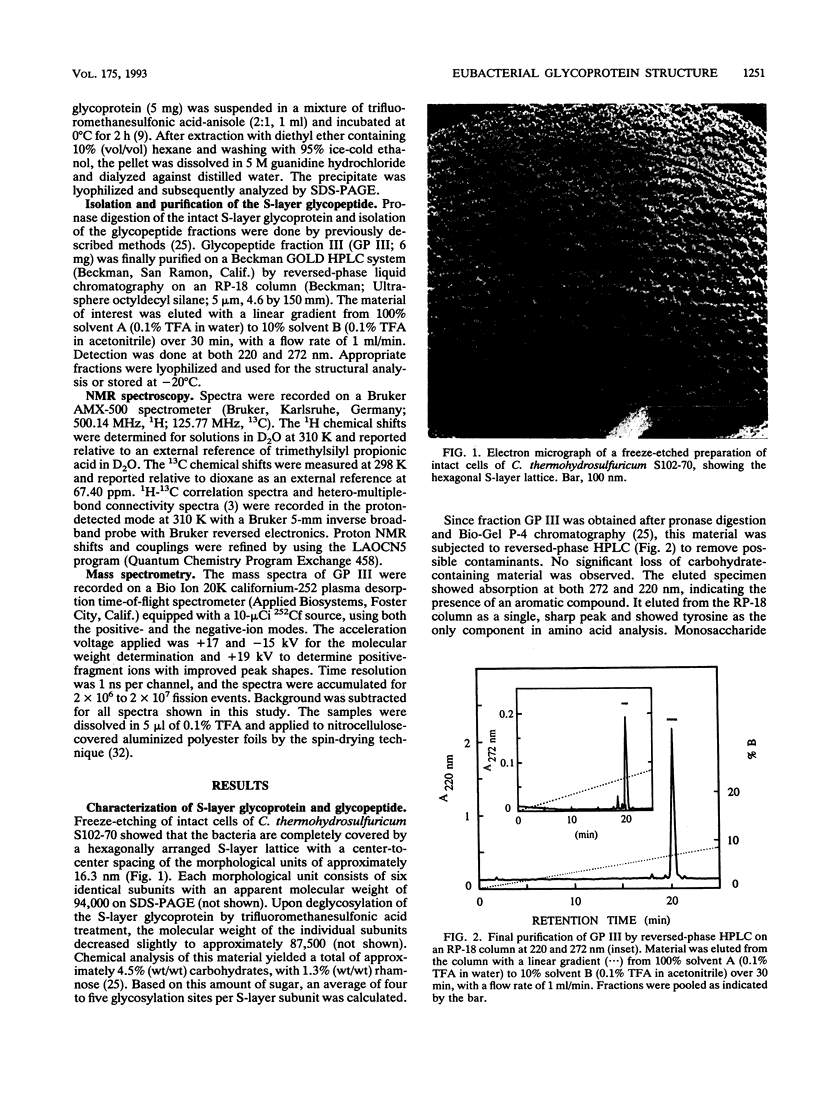

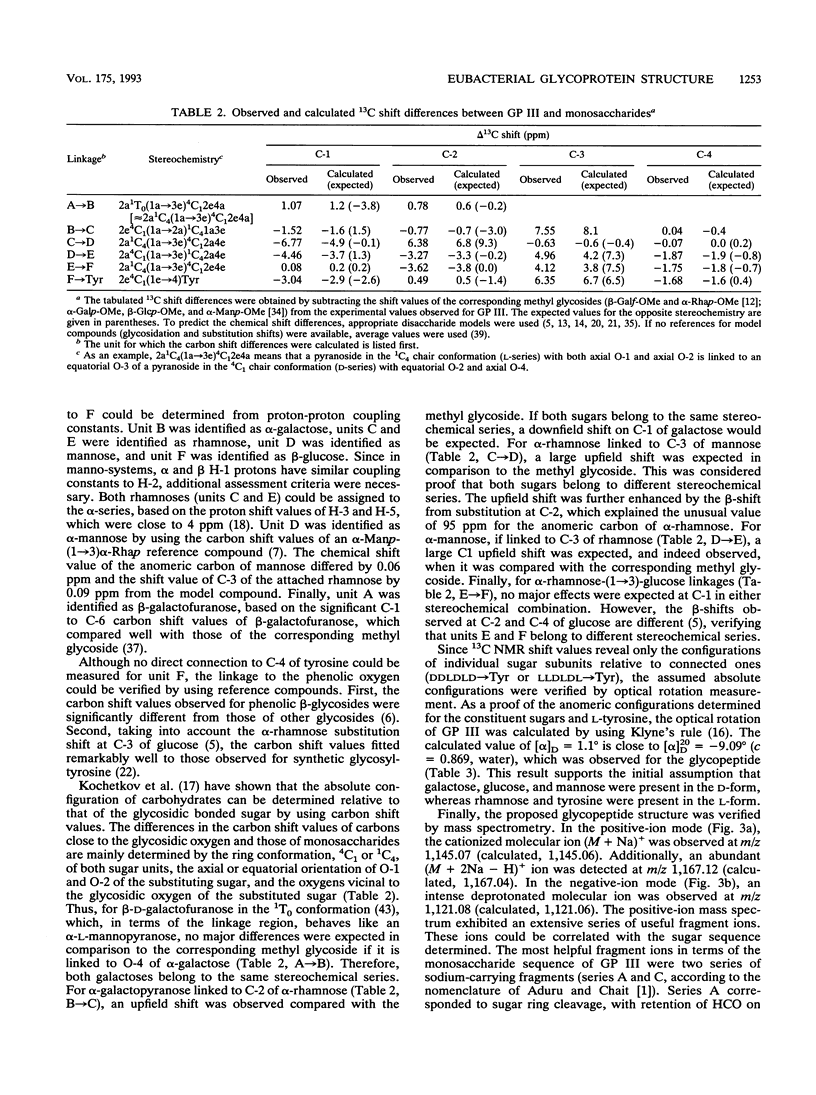
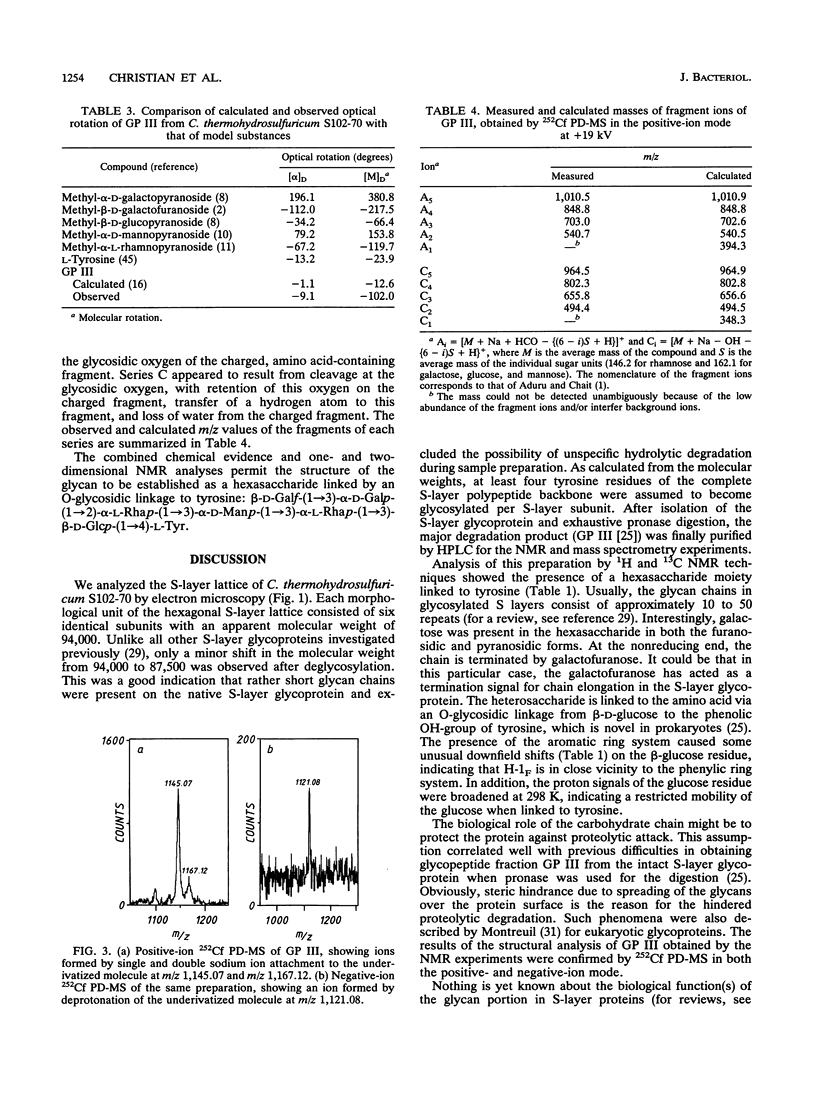
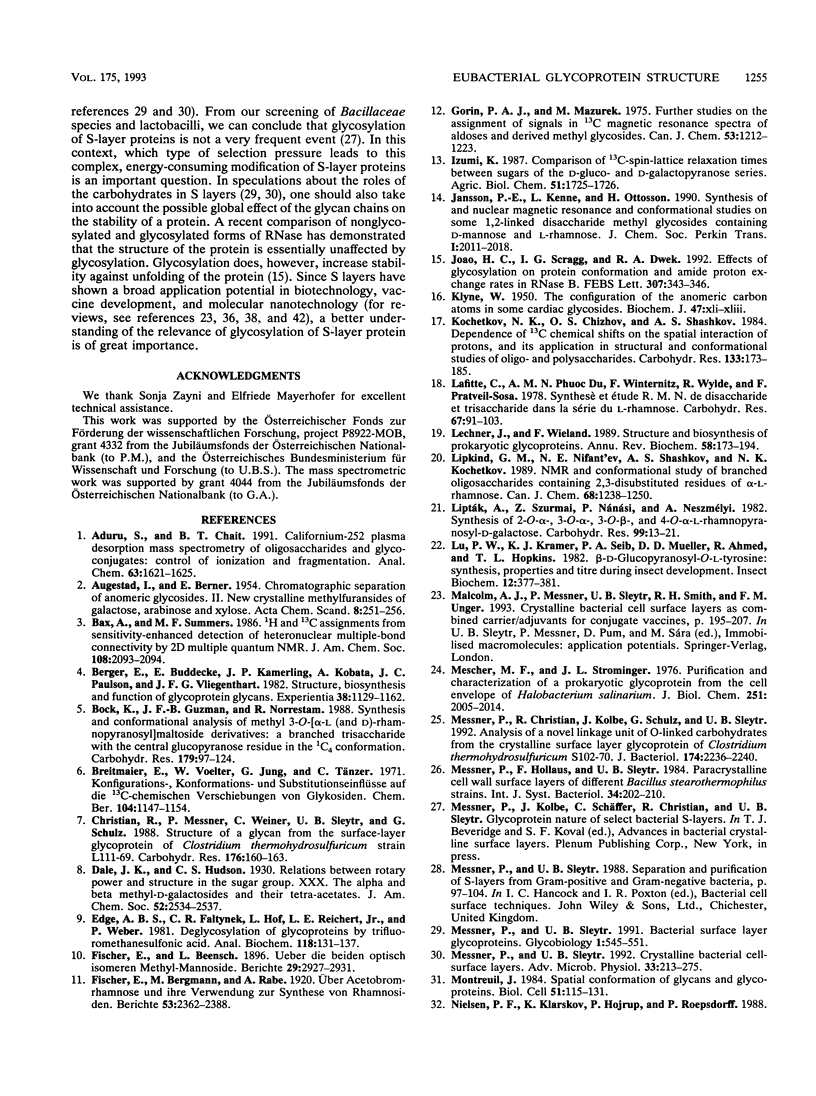
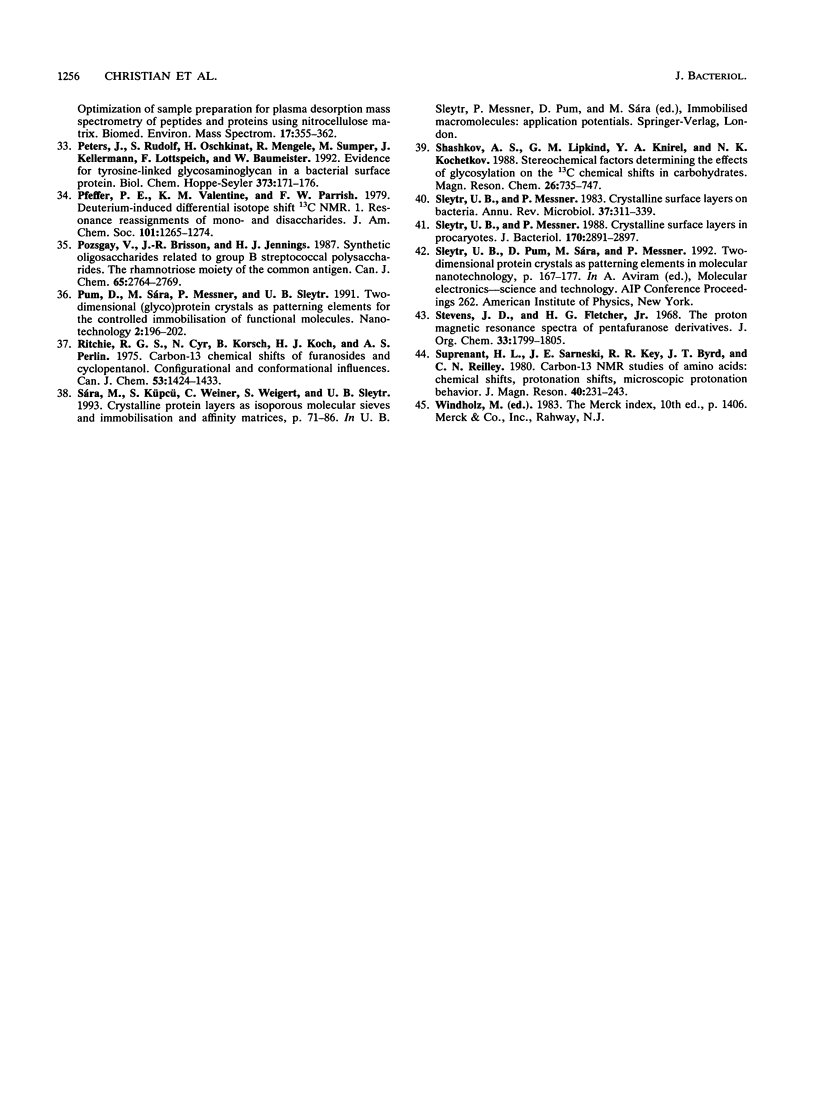
Images in this article
Selected References
These references are in PubMed. This may not be the complete list of references from this article.
- Aduru S., Chait B. T. Californium-252 plasma desorption mass spectrometry of oligosaccharides and glycoconjugates: control of ionization and fragmentation. Anal Chem. 1991 Aug 1;63(15):1621–1625. doi: 10.1021/ac00015a023. [DOI] [PubMed] [Google Scholar]
- Berger E. G., Buddecke E., Kamerling J. P., Kobata A., Paulson J. C., Vliegenthart J. F. Structure, biosynthesis and functions of glycoprotein glycans. Experientia. 1982 Oct 15;38(10):1129–1162. doi: 10.1007/BF01959725. [DOI] [PubMed] [Google Scholar]
- Christian R., Messner P., Weiner C., Sleytr U. B., Schulz G. Structure of a glycan from the surface-layer glycoprotein of Clostridium thermohydrosulfuricum strain L111-69. Carbohydr Res. 1988 May 1;176(1):160–163. doi: 10.1016/0008-6215(88)84069-2. [DOI] [PubMed] [Google Scholar]
- Edge A. S., Faltynek C. R., Hof L., Reichert L. E., Jr, Weber P. Deglycosylation of glycoproteins by trifluoromethanesulfonic acid. Anal Biochem. 1981 Nov 15;118(1):131–137. doi: 10.1016/0003-2697(81)90168-8. [DOI] [PubMed] [Google Scholar]
- Joao H. C., Scragg I. G., Dwek R. A. Effects of glycosylation on protein conformation and amide proton exchange rates in RNase B. FEBS Lett. 1992 Aug 3;307(3):343–346. doi: 10.1016/0014-5793(92)80709-p. [DOI] [PubMed] [Google Scholar]
- Lechner J., Wieland F. Structure and biosynthesis of prokaryotic glycoproteins. Annu Rev Biochem. 1989;58:173–194. doi: 10.1146/annurev.bi.58.070189.001133. [DOI] [PubMed] [Google Scholar]
- Mescher M. F., Strominger J. L. Purification and characterization of a prokaryotic glucoprotein from the cell envelope of Halobacterium salinarium. J Biol Chem. 1976 Apr 10;251(7):2005–2014. [PubMed] [Google Scholar]
- Messner P., Christian R., Kolbe J., Schulz G., Sleytr U. B. Analysis of a novel linkage unit of O-linked carbohydrates from the crystalline surface layer glycoprotein of Clostridium thermohydrosulfuricum S102-70. J Bacteriol. 1992 Apr;174(7):2236–2240. doi: 10.1128/jb.174.7.2236-2240.1992. [DOI] [PMC free article] [PubMed] [Google Scholar]
- Messner P., Sleytr U. B. Bacterial surface layer glycoproteins. Glycobiology. 1991 Dec;1(6):545–551. doi: 10.1093/glycob/1.6.545. [DOI] [PubMed] [Google Scholar]
- Messner P., Sleytr U. B. Crystalline bacterial cell-surface layers. Adv Microb Physiol. 1992;33:213–275. doi: 10.1016/s0065-2911(08)60218-0. [DOI] [PubMed] [Google Scholar]
- Montreuil J. Spatial conformation of glycans and glycoproteins. Biol Cell. 1984;51(2):115–131. doi: 10.1111/j.1768-322x.1984.tb00291.x. [DOI] [PubMed] [Google Scholar]
- Peters J., Rudolf S., Oschkinat H., Mengele R., Sumper M., Kellermann J., Lottspeich F., Baumeister W. Evidence for tyrosine-linked glycosaminoglycan in a bacterial surface protein. Biol Chem Hoppe Seyler. 1992 Apr;373(4):171–176. doi: 10.1515/bchm3.1992.373.1.171. [DOI] [PubMed] [Google Scholar]
- Sleytr U. B., Messner P. Crystalline surface layers in procaryotes. J Bacteriol. 1988 Jul;170(7):2891–2897. doi: 10.1128/jb.170.7.2891-2897.1988. [DOI] [PMC free article] [PubMed] [Google Scholar]
- Sleytr U. B., Messner P. Crystalline surface layers on bacteria. Annu Rev Microbiol. 1983;37:311–339. doi: 10.1146/annurev.mi.37.100183.001523. [DOI] [PubMed] [Google Scholar]
- Stevens J. D., Fletcher H. G., Jr The proton magnetic resonance spectra of pentofuranose derivatives. J Org Chem. 1968 May;33(5):1799–1805. doi: 10.1021/jo01269a021. [DOI] [PubMed] [Google Scholar]



